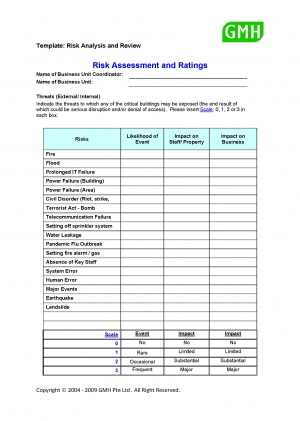Guidance Notes-RAR: Difference between revisions
Jump to navigation
Jump to search
m Hua Wei moved page Guidance Notes-RAR-v2 to Guidance Notes-RAR |
(No difference)
|
Latest revision as of 12:13, 13 January 2020



This template is provided to all participants during a typical Risk Assessment workshop for the purpose of scoring the:
- List of Potential Threats (Column 1: Threats)
- Probability of Event Occurring (Column 2: Probability of Event Occurring)
- Assess Potential Human and Property Impact (Column 3: Impact on Staff/ Property)
- Assess the Potential Business Impact (Column 4: Impact on Business)
Column One: List Potential Threats
- List the types of threats that could affect the organization.
- Refer to List of Threats
- Consider threats that had occurred previously to your organization and its surrounding environment.
- Consider threats that have occurred before as well
- Refer to List of Threats for example, fire, landslides, severe weather, flood, hazardous material spills, transportation accidents, utility outages, or terrorist attacks.
- Keep in mind the organization’s physical location with regard to storage of fuel, low laying flood plains, areas of hazardous material storage or use, transportation routes, pipelines, major power transmission facilities, and laboratories.
- Consider the technological systems the organization relies upon
- Refer to List of Threats for example, telecommunications, power, heating and cooling, emergency notification or security systems, and computer networks.
- Take into account the threat to human as well.
- Consider the physical construction of the facility, access to dual power grids, adequacy of lighting, sufficient emergency exits, evacuation plans and routes, proximity to shelter, and possible alternate locations to continue operations through and following an incident.
Column Two: Estimate Probability
- Rate the likelihood of each event occurring.
- This is usually based on a subjective consideration, but you may find this exercise useful as this is the next best approach to deriving the probability.
- Perform an assessment on the Likelihood of the Event happening and anticipate based on recency of events occurrence.
Column Three: Assess Potential Human Impact
- Analyze the potential human impact on the organization such as the possibility of personnel being killed, injured, or rendered ineffective and by each type of threat.
- Consider if staff members will be available to respond to work in the event the threat is wide-ranging.
Column Three: Assess Potential Property Impact
- Consider the potential losses and damages to property caused by each incident, and the impact on the organization.
- Consider the cost to repair or replace equipment, and the availability of such equipment.
Column Four: Assess the Potential Business Impact
- Determine the potential impact of each incident on the organization’s operations.
- Consider the difficulty that an operation will need to prepare itself to continue through such an event.
- Take into account the availability of alternate locations, work space, and support for the business functions.
- Deliberate the cost to establish temporary operations in the alternate location.
- Consider the ability of workers to continue to respond to the business unit.
- Consider the impact of interruption of critical supplies or services to the business units.
- Consider the interruption of the product or information distribution.
Courses